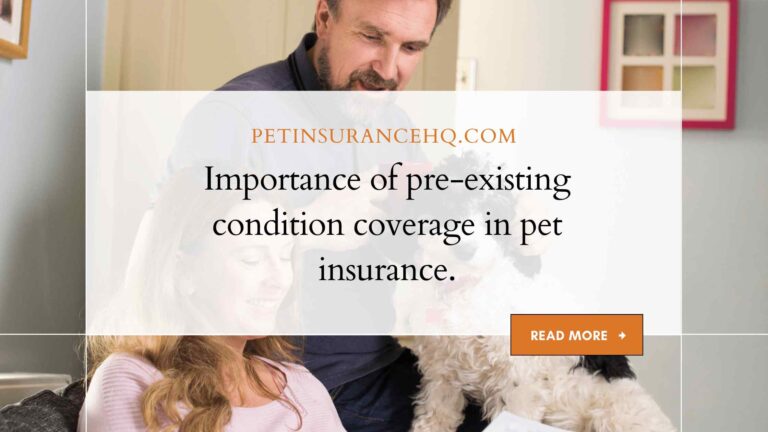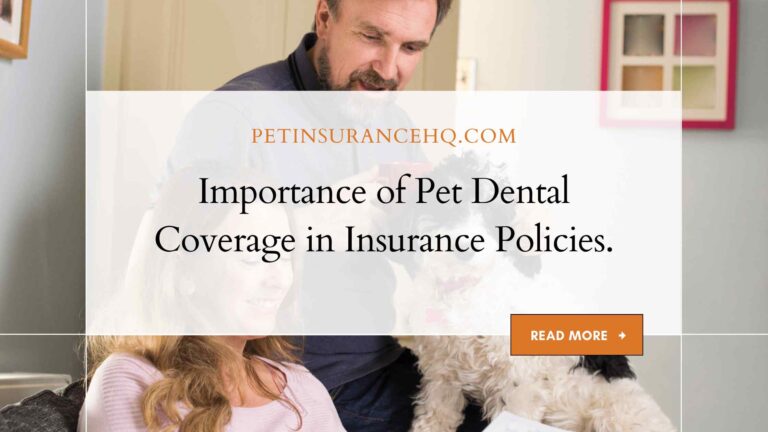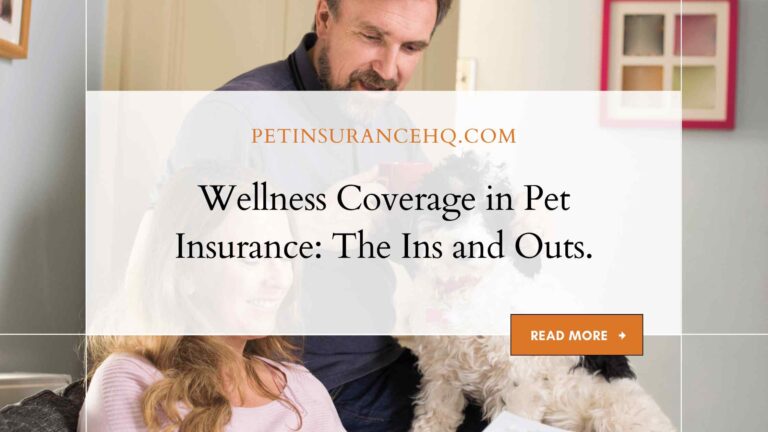Understanding the Exclusions in Your Pet Insurance Policy
As pet owners, we want nothing but the best for our furry friends – from their food, toys, to even their health care. While investing in a comprehensive pet insurance policy can give us peace of mind when it comes to ensuring our pets’ well-being, reading through the fine print can be overwhelming and confusing. One crucial aspect that most pet owners tend to overlook is understanding what’s not covered under their insurance policy – and this could quickly turn into a nasty surprise when faced with unexpected medical bills.
In this blog post, we’ll delve into everything you need to know about exclusions in your pet insurance policy so you can make informed decisions and protect your fur baby’s health without breaking the bank!
What is Pet Insurance?
As a pet owner, it’s important to understand what your pet insurance policy covers and doesn’t cover. Otherwise, you could be left with a huge vet bill that you can’t afford to pay. Pet insurance typically excludes pre-existing conditions, routine care, cosmetic procedures, and hereditary or congenital conditions.
Pre-existing conditions are any illnesses or injuries that your pet has before you enroll them in a pet insurance policy. Routine care includes things like vaccinations and check-ups. Cosmetic procedures are things like teeth cleaning or hair removal. Hereditary or congenital conditions are conditions that your pet is born with or that develop over time due to their genes.
While it’s important to know what isn’t covered by your pet insurance policy, don’t let that deter you from getting coverage for your furry friend. Pet insurance can still help you with unexpected vet bills for things like accidents and illnesses. Plus, it peace of mind knowing that you’re prepared for the worst case scenario.
What are Exclusions in Pet Insurance Policies?

There are a few things that most pet insurance policies exclude from coverage. These exclusions are important to understand because they can help you make the best decision for your pet regarding their insurance coverage.
The first thing that is typically excluded from pet insurance policies is any pre-existing conditions that your pet may have. This means that if your pet has any condition that existed before you purchased the policy, it will not be covered under the policy. This is why it’s so important to get pet insurance as soon as possible after getting your pet, because any conditions they develop after you’ve bought the policy will be covered.
Another common exclusion in pet insurance policies is routine care, such as vaccinations and routine check-ups. However, many insurers will offer some coverage for routine care if you purchase a rider to add on to your policy. This rider can help offset the costs of routine care, but it’s important to understand that it will not cover the full cost of these services.
Most pet insurance policies exclude any injuries or illnesses that are considered hereditary or congenital. This means that if your pet has a condition that is passed down from their parents or is present at birth, it will not be covered under the policy. While this exclusion may seem unfair, it’s important to remember that these conditions are often untreatable and can be very expensive to manage.
Types of Exclusions
There are many different types of exclusions that can be found in pet insurance policies. Some of the most common exclusions include:
- Pre-existing conditions: Most pet insurance policies will not cover any condition that your pet has prior to enrolling in the policy. This is because these conditions are considered to be preexisting and are not covered under the policy.
- Congenital conditions: Conditions that your pet is born with (congenital) are also typically excluded from coverage.
- Preventative care: Many policies will not cover routine or preventative care, such as vaccinations, check-ups, and teeth cleanings.
- Elective procedures: Procedures that are not medically necessary, such as spaying/neutering, are often excluded from coverage.
It’s important to read through your pet insurance policy carefully to understand all of the exclusions that apply. This way, you can be prepared for any out-of-pocket costs that may arise if your pet needs treatment for a condition that is not covered under the policy.
Who is Covered and Who isn’t?
There are a few different types of exclude that pet insurance companies use which can be generally summarised as pre-existing, congenital and hereditary conditions, and behavioural conditions.
Pre-existing Conditions: A pre-existing condition is any illness or injury your pet has before you take out cover or during the waiting period. Because your pet has already been diagnosed with this condition, the insurance company may refuse to pay out for treatment relating to it or only offer limited cover.
Congenital & Hereditary Conditions: These are health problems that are present at birth or develop over time due to your pet’s genes. Some common congenital conditions include heart defects, hip dysplasia and elbow dysplasia. Hereditary conditions are passed down from parents to offspring and can include issues such as cancer, diabetes and joint problems.
Behavioural Conditions: Pets can also suffer from behavioural problems which aren’t always covered by pet insurance. This is because these conditions are often considered to be preventable with proper training and management. Some common behavioural problems include aggression, excessive barking and destructiveness.
What Are Some Examples of Exclusions in a Typical Pet Insurance Policy?
Most pet insurance policies have common exclusions, such as pre-existing conditions, hereditary or congenital conditions, routine care, experimental treatment, and more. Here are some specific examples of exclusions that may be found in a typical pet insurance policy:
- Hereditary or congenital conditions: Conditions that are passed down from your pet’s parents or that your pet is born with are often excluded from coverage.
- Routine care: Vaccinations, routine wellness exams, teeth cleanings, etc. are usually not covered by pet insurance policies.
- Experimental treatment: Treatments that are not yet FDA approved or that are considered to be experimental are often excluded from coverage.
- Behavioral problems: Many policies will exclude coverage for behavioral problems like excessive barking, chewing, biting, etc.
How Do You Find the Right Exclusions for Your Pet Insurance Policy?
When it comes to pet insurance, exclusions are pretty much par for the course. But that doesn’t mean you should just accept them without question. In fact, it’s important to understand exactly what your policy excludes so that you can make an informed decision about whether or not it’s the right coverage for you and your pet.
So, how do you find the right exclusions for your pet insurance policy? Here are a few things to keep in mind:
- Pre-existing conditions are usually excluded from coverage.
This is probably the most common exclusion in pet insurance policies. If your pet has any condition that existed prior to signing up for coverage, it’s generally not going to be covered. That said, there are some insurers who will make exceptions for certain pre-existing conditions if they’re not considered “high risk.” So, it’s always worth checking with your insurer to see if they have any flexibility on this issue.
- Routine care is often excluded from coverage.
This includes things like vaccinations, routine check-ups, and teeth cleanings. Some policies will offer limited coverage for routine care, while others exclude it entirely. Again, it depends on the insurer, so be sure to ask about this before signing up for a policy.
- Elective procedures are usually excluded from coverage.
This includes things like cosmetic surgery, declawing, and tail docking. If you’re considering one of these procedures for your pet, it’s best to factor in the cost of the procedure when figuring out how much insurance coverage you need.
- Congenital conditions are sometimes excluded from coverage.
If your pet is born with a condition (like hip dysplasia or heart defects), it may not be covered by your policy. Again, it depends on the insurer, so be sure to ask about this before signing up for a policy.
- Behavioral issues are rarely covered by pet insurance policies.
This includes things like excessive barking, house soiling, and destructiveness – all of which fall under the umbrella of “behavioral issues” that most insurers don’t cover. If these types of issues are a concern for you, you may want to look into specialty coverage specifically designed to address them.
By taking the time to understand exactly what is and isn’t covered by your pet insurance policy, you can ensure that you’re getting the right level of coverage for your furry friend – without any unpleasant surprises down the road.
Conclusion
Pet insurance can be a valuable asset in protecting your furry family member and helping you manage the financial stress of unexpected veterinary expenses. Knowing what all of the caveats and exclusions in your pet insurance policy mean is essential to making sure that your coverage applies when you need it most. We hope this article has given you more information on understanding these exclusions so that you can select a plan with an appropriate level of protection for your beloved companion.







